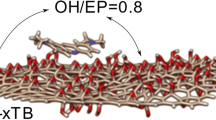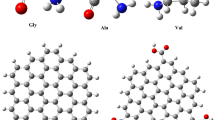Abstract
The non-dissociative and dissociative adsorptions of zwitterionic Gly on graphene oxide (GO) was studied in the framework of DFT using a cluster model approach. In this work, the interaction with an epoxy group of GO basal plane was mainly considered. As a comparison, the non-dissociative and dissociative adsorptions of neutral Gly were also taken into account. The non-dissociative adsorption modes for zwitterionic and neutral Gly conformers show binding energies of 12.2 and 14.4 kcal mol−1, respectively. These molecules are thought to remain over the GO surface due to attractive noncovalent interactions. Two dissociative adsorption modes, for Z-Gly and N-Gly, show smaller binding energies of 7.2 and 8.4 kcal mol−1, where the deprotonated species links strongly through a C–O or C–N covalent bond to the GO surface. The results obtained in the present theoretical approach to the glycine/graphene oxide system support the fact that glycine can be attached to epoxy groups of graphene oxide basal planes in addition to the anchoring on edge oxidation groups. In summary, we conclude that glycine can be used as a reducing agent as well as a functionalizer of GO sheets.






Similar content being viewed by others
References
Motta A, Gaigeot M-P, Costa D (2012) AIMD evidence of inner sphere adsorption of glycine on a stepped (101) boehmite AlOOH surface. J Phys Chem C 116:23418–23427
Domínguez A, Moreira NH, Dolgonos G, Frauenheim T, Da Rosa AL (2011) Glycine adsorption on (10-10) ZnO surfaces. J Phys Chem C 115:6491–6495
Duncan DA, Bradley MK, Unterberger W, Kreikemeyer-Lorenzo D, Lerotholi TJ, Robinson J, Woodruff DP (2012) Deprotonated glycine on Cu(111): quantitative structure determination by energy-scanned photoelectron diffraction. J Phys Chem C 116:9985–9995
Soltani A, Azmoodeh Z, Javan MB, Lemeski ET, Karami L (2016) A DFT study of adsorption of glycine onto the surface of BC2N nanotube. Appl Surf Sci 384:230–236
Larijani HT, Jahanshahi M, Ganji MD, Kiani MH (2017) Computational studies on the interactions of glycine amino acid with graphene, h-BN and h-SiC monolayers. Phys Chem Chem Phys 19:1896–1908
Ersan F, Aktürk E, Ciraci S (2019) Glycine self-assembled on graphene enhances the solar absorbance performance. Carbon 143:329–334
Ersan F, Aktürk OÜ, Aktürk E, Ciraci S (2018) Metal−insulator transition and heterostructure formation by glycines self-assembled on defect-patterned graphene. J Phys Chem C 122:14598–14605
Bose S, Kuila T, Mishra AK, Kim NH, Lee JH (2012) Dual role of glycine as a chemical functionalizer and a reducing agent in the preparation of graphene: an environmentally friendly method. J Mater Chem 22:9696–9703
Chua CK, Pumera M (2014) Chemical reduction of graphene oxide: a synthetic chemistry viewpoint. Chem Soc Rev 43:291–312
Thakur S, Karak N (2015) Alternative methods and nature-based reagents for the reduction of graphene oxide: a review. Carbon 94:224–242
Tran DNH, Kabiri S, Losic D (2014) A green approach for the reduction of graphene oxide nanosheets using non-aromatic amino acids. Carbon 76:193–202
Wang J, Salihi EC, Šiller L (2017) Green reduction of graphene oxide using alanine. Mater Sci Eng C 72:1–6
Najafi F (2015) Removal of zinc (II) ion by graphene oxide (GO) and functionalized graphene oxide-glycine (GO-G) as adsorbents from aqueous solution: kinetics studies. Int Nano Lett 5:171–178
Najafi F, Moradi O, Rajabi M, Asif M, Tyagi I, Agarwal S, Gupta VK (2015) Thermodynamics of the adsorption of nickel ions from aqueous phase using graphene oxide and glycine functionalized graphene oxide. J Mol Liq 208:106–113
Li J, Wang S, Zhang D, Ni X, Zhang Q (2016) Amino acids functionalized Graphene oxide for enhanced hydrophilicity and antifouling property of poly (vinylidene fluoride) membranes. Chin J Polym Sci 34:805–819
Wang MH, Guo YN, Wang Q, Zhang XSY, Huang JJ, Lu X, Wang KF, Zhang HP, Leng Y (2014) Density functional theory study of interactions between glycine and TiO2/graphene nanocomposites. Chem Phys Lett 599:86–91
Gaussian 16, Revision B.01, Frisch MJ et al. Gaussian, Inc., Wallingford CT, 2016
Becke AD (1993) Density-functional thermochemistry. III. The role of exact exchange. J Chem Phys 98:5648–5652
Grimme S, Antony J, Ehrlich S, Krieg H (2010) A consistent and accurate ab initio parametrization of density functional dispersion correction (DFT-D) for the 94 elements H-Pu. J Chem Phys 132:154104
Grimme S, Ehrlich S, Goerigk L (2011) Effect of the damping function in dispersion corrected density functional theory. J Comput Chem 32:1456–1465
Singla P, Riyaz M, Singhal S, Neetu Goel N (2016) Theoretical study of adsorption of amino acids on graphene and BN sheet in gas and aqueous phase including empirical DFT dispersion correction. Phys Chem Chem Phys 18:5597–5604
Mollenhauer D, Brieger C, Voloshina E, Paulus B (2015) Performance of dispersion-corrected DFT for the weak interaction between aromatic molecules and extended carbon-based systems. J Phys Chem C 119:1898–1904
Cortés-Arriagada D, Toro-Labbé A (2015) Improving As (III) adsorption on graphene based surfaces: impact of chemical doping. Phys Chem Chem Phys 17:12056–12064
Domancich NF, Ferullo RM, Castellani NJ (2015) Interaction of aluminum dimer with defective graphene. Comput Theor Chem 1059:27–34
Friant-Michel P, Ruiz-López MF (2010) Glycine dimers: structure, stability, and medium effects. ChemPhysChem 11:3499–3504
Ding Y, Krogh-Jespersen K (1992) The glycine zwitterion does not exist in the gas phase: results from a detailed ab initio electronic structure study. Chem Phys Lett 199:261–266
Xu S, Nilles JM, Kit J, Bowen H (2003) Zwitterion formation in hydrated amino acid, dipole bound anions: how many water molecules are required? J Chem Phys 119:10696–10701
Miertuš S, Tomasi J (1982) Approximate evaluations of the electrostatic free energy and internal energy changes in solution processes. Chem Phys 65:239–245
Cancès E, Mennucci B, Tomasi J (1997) A new integral equation formalism for the polarizable continuum model: theoretical background and applications to isotropic and anisotropic dielectrics. J Chem Phys 107:3032–3041
Tomasi J, Mennucci B, Cammi R (2005) Quantum mechanical continuum solvation models. Chem Rev 105:2999–3093
Weinhold F, Landis CR, Glendening ED (2016) What is NBO analysisand how is it useful? Int Rev Phys Chem 35:399–440
Wiberg KB (1968) Application of the pople-santry-segal CNDO method to the cyclopropylcarbinyl and cyclobutyl cation and to bicyclobutane. Tetrahedron 24:1083–1096
Fonseca Guerra C, Handgraaf J-W, Baerends EJ, Bickelhaupt FM (2004) Voronoid deformation density (VDD) charges: assessment of the Mulliken, Bader, Hirshfeld, Weinhold, and VDD methods for charge analysis. J Comput Chem 25:189–210
Contreras-García J, Johnson ER, Keinan S, Chaudret R, Piquemal J-P, Beratan DN, Yang W (2011) NCIPLOT: a program for plotting noncovalent interaction regions. J Chem Theory Comput 7:625–632
Papajak E, Zheng J, Xu X, Leverentz HR, Truhlar DG (2011) Perspectives on basis sets beautiful: seasonal plantings of diffuse basis functions. J Chem Theory Comput 7:3027–3034
Gonthier JF, Sherrill CD (2016) Density-fitted open-shell symmetry-adapted perturbation theory and application to π-stacking in benzene dimer cation and ionized DNA base pair steps. J Chem Phys 145(134106):1–11
Weigend F, Köhn A, Hättig C (2002) Efficient use of the correlation consistent basis sets in resolution of the identity MP2 calculations. J Chem Phys 116(8):3175–3183
Hättig C (2005) Optimization of auxiliary basis sets for RI-MP2 and RI-CC2 calculations: core–valence and quintuple-f basis sets for H to Ar and QZVPP basis sets for Li to Kr. Phys Chem Chem Phys 7:59–66
Parrish RM, Burns LA, Smith DGA et al (2017) An open-source electronic structure program emphasizing automation, advanced libraries, and interoperability. J Chem Theory Comput 13:3185–3197
Parker TM, Burns LA, Parrish RM, Ryno AG, Sherrilla CD (2014) Levels of symmetry adapted perturbation theory (SAPT). I. Efficiency and performance for interaction energies. J Chem Phys 140(094106):1–16
CYLview, 1.0b; Legault, C. Y., Université de Sherbrooke, 2009 (http://www.cylview.org)
Chemcraft - graphical software for visualization of quantum chemistry computations. https://www.chemcraftprog.com
Hanwell MD, Curtis DE, Lonie DC, Vandermeersch T, Zurek E, Hutchison GR (2012) Avogadro: an advanced semantic chemical editor, visualization, and analysis platform. Cheminformatics 4:1–17
Larijani HT, Ganji MD, Jahanshahi M (2015) Trends on the amino acids adsorption onto the graphene and graphene oxide surface: a dispersion corrected DFT study. RSC Adv 5:92843–92857
Domancich N, Rossi Fernández A, Meier L, Fuente S, Castellani N (2019) DFT study of graphene oxide reduction by a dopamine species. Mol Phys. https://doi.org/10.1080/00268976.2019.1637029
Jeffrey GA (1997) An introduction to hydrogen bonding. Oxford University Press, New York and Oxford, p 11
Bistoni G, Rampino S, Tarantelli F, Belpassi L (2015) Charge-displacement analysis via natural orbitals for chemical valence: charge transfer effects in coordination chemistry. J Chem Phys 142(084112):1–9. https://doi.org/10.1063/1.4908537
Salvadori A, Fusè M, Mancini G, Rampino S, Barone V (2018) Diving into chemical bonding: an immersive analysis of the electron charge rearrangement through virtual reality. J Comput Chem 39:2607–2617
Funding
NVE., DGA, SGO, and ATL acknowledge financial support from Fondecyt project number 1181072. NVE wishes to acknowledge CONICYT-PCHA/Doctorado Nacional/2016-21161677. ACRF, RF, and NJC acknowledge financial support from Consejo Nacional de Investigaciones Científicas y Técnicas of Argentina. ACRF also acknowledges financial support from Universidad Nacional del Sur.
Author information
Authors and Affiliations
Corresponding author
Additional information
Publisher’s note
Springer Nature remains neutral with regard to jurisdictional claims in published maps and institutional affiliations.
This paper belongs to Topical Collection QUITEL 2018 (44th Congress of Theoretical Chemists of Latin Expression)
Rights and permissions
About this article
Cite this article
Rossi-Fernández, A.C., Villegas-Escobar, N., Guzmán-Angel, D. et al. Theoretical study of glycine amino acid adsorption on graphene oxide. J Mol Model 26, 33 (2020). https://doi.org/10.1007/s00894-020-4297-8
Received:
Accepted:
Published:
DOI: https://doi.org/10.1007/s00894-020-4297-8




